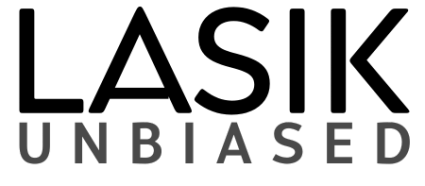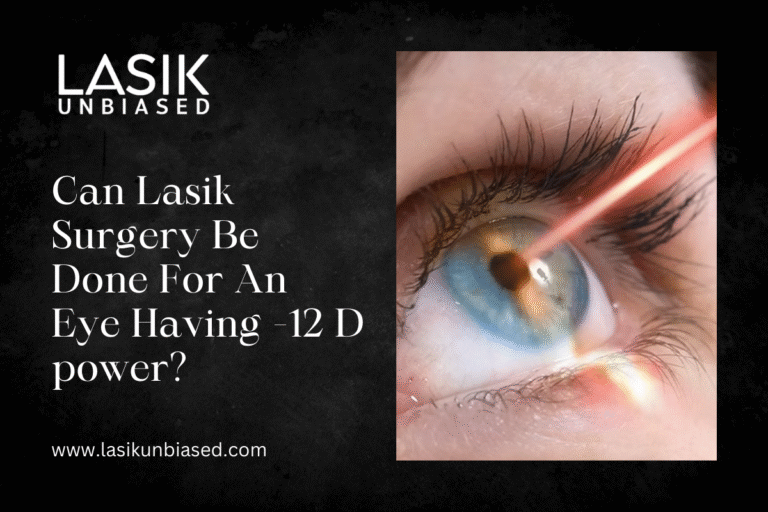LASIK surgery is generally not recommended for individuals with -12 diopters (D) of myopia.
The ideal upper limit for LASIK is -8.0 D, while some carefully selected cases may go up to -10.0 D.
For anyone with a prescription of -12 D, LASIK falls outside the safe and effective treatment range. While it’s natural to want to reduce dependency on glasses or contact lenses, understanding the limits of LASIK and exploring alternative procedures is key to making an informed decision.
Why -12 D Is Beyond the LASIK Safety Threshold?
The primary reason LASIK is not advised for -12 D myopia is the volume of corneal tissue that must be removed to correct such a high degree of nearsightedness. LASIK works by reshaping the cornea with a laser so that light entering the eye focuses correctly on the retina.
- The higher the myopia, the more corneal tissue must be ablated.
- For -12 D, the amount of tissue typically required often exceeds safe surgical limits, potentially compromising the cornea’s structural integrity, even in patients with above-average corneal thickness.
According to ophthalmic safety standards, surgeons aim to preserve at least 250 microns of residual stromal bed (the remaining central corneal thickness after laser reshaping). In -12 D corrections, this safety margin is often unattainable.
Understanding the LASIK Power Limit: Why Is -8 D Ideal?
The ideal upper limit for LASIK surgery is typically -8.0 D. This recommendation is based on:
- Corneal Thickness: Most people have a corneal thickness between 500–600 microns. LASIK requires both flap creation (around 100–120 microns) and laser ablation. Correcting -12 D may require between 144 to 192 microns of ablation, depending on the laser type and optical zone size, making it unsafe for most patients.
- Visual Quality: Higher corrections carry increased risk of side effects such as glare, halos, reduced night vision, and overcorrection or undercorrection.
- Long-Term Stability: Post-LASIK regression is more common in higher prescriptions, meaning vision may deteriorate again over time.
LASIK’s suitability is not just about how bad the vision is—it’s about whether your eye can safely accommodate the required changes.
Corneal Biomechanics and LASIK Risk in High Myopia
When correcting -12 D, the LASIK procedure places significant biomechanical stress on the cornea. Even if technically feasible, this can lead to:
- Corneal ectasia, a condition where the cornea weakens and begins to bulge outward, causing visual distortion.
- Irregular astigmatism, which can make vision blurrier and harder to correct with glasses or contacts.
These complications can be irreversible and may require complex management, such as corneal cross-linking or even corneal transplant in extreme cases.
Does Corneal Thickness Allow LASIK at -12 D?
In very rare cases, a patient might have an exceptionally thick cornea, theoretically allowing enough tissue for safe ablation. However, this is extremely uncommon.
Even if the cornea is thick enough, other factors must be evaluated:
- Topography and shape of the cornea.
- Pupil size, which can affect night vision quality post-surgery.
- Tear film health, as higher corrections can worsen post-operative dry eyes.
Because so many variables are involved, only an experienced ophthalmologist can determine if you’re an outlier who qualifies for LASIK with -12 D, and even then, the recommendation often leans toward safer alternatives.
Better Alternatives to LASIK for -12 D Vision Correction
If you’re not a LASIK candidate, don’t worry. Modern ophthalmology offers multiple advanced alternatives that are safer and more effective for extreme myopia.
1. Implantable Collamer Lens (ICL)
ICL is the gold-standard alternative for -12 D and even higher prescriptions.
- A soft, biocompatible lens is carefully implanted within the eye, positioned between the iris and the natural lens.
- No corneal tissue is removed, so the structure of the eye remains intact.
- The lens is invisible to the naked eye and can be removed or replaced in the future.
Why ICL is ideal for -12 D:
- FDA-approved for corrections up to -15 D.
- Does not rely on corneal thickness.
- Delivers sharp, stable vision with fewer long-term complications.
2. Refractive Lens Exchange (RLE)
Refractive Lens Exchange is a procedure where the natural lens of the eye is replaced with an artificial intraocular lens (IOL), similar to cataract surgery.
- Ideal for patients over 40 or those showing early signs of cataracts or lens changes.
- Offers permanent correction and can also address presbyopia (age-related near vision loss).
- Particularly useful if you’re at risk for early cataracts or have thin corneas.
3. Photorefractive Keratectomy (PRK)
PRK is another laser-based surgery that does not involve creating a corneal flap, unlike LASIK. It’s used for patients with thinner corneas.
- PRK can treat myopia up to -12 D, making it a viable option for very high myopia in select cases, depending on corneal thickness and other ocular health factors.
- PRK involves a longer recovery time but can reduce flap-related risks.
Risks of Attempting LASIK at -12 D
Attempting LASIK outside the recommended power limits can result in:
- Severe corneal ectasia
- Chronic dry eyes
- Double vision or ghosting
- Ongoing dependence on glasses or contacts
- Potential need for retreatment or reversal procedures
Choosing the right procedure based on your eye’s anatomy, not just your prescription, is crucial.
What to Expect During an Evaluation for -12 D Correction?
If you’re considering refractive surgery, expect your ophthalmologist to conduct a comprehensive diagnostic evaluation, including:
- Corneal pachymetry (to measure thickness)
- Topography (to map corneal surface)
- Wavefront analysis (to assess optical aberrations)
- Pupil dilation and retinal health check
- Tear film and dry eye testing
This thorough evaluation helps determine the safest and most effective procedure—LASIK, ICL, RLE, or another custom solution.
Cost Considerations and Long-Term Value
While LASIK is often more affordable upfront, ICL and RLE may have higher initial costs but offer greater value for high myopia patients:
- Better visual outcomes
- Lower risk of complications
- Reduced need for enhancements or glasses
Investing in the right procedure ensures lasting clarity and long-term eye health.
Key Takeaways: Can LASIK Be Done at -12 D?
- LASIK is almost never recommended for -12 D due to the significant risks outweighing potential benefits. In extremely rare cases, it may be technically possible, but safer alternatives are strongly preferred.
- The ideal upper limit is -8.0 D, and the absolute maximum is around -10.0 D in select cases.
- ICL is the most reliable option for extreme myopia, offering excellent safety and vision quality.
- RLE and PRK may be considered in certain scenarios, depending on age and eye anatomy.
- Always undergo a detailed consultation with a refractive surgeon to identify your best option.
Conclusion: The Right Procedure for Your Vision Goals
If you’re living with -12 D myopia, LASIK may not be your solution, but your vision can still be corrected. Thanks to advancements like ICL and RLE, patients with high prescriptions now have access to precise, stable, and safe alternatives.
Don’t let LASIK limits hold you back. Book a consultation with a qualified eye surgeon and discover the most suitable path toward clear, glasses-free vision.


